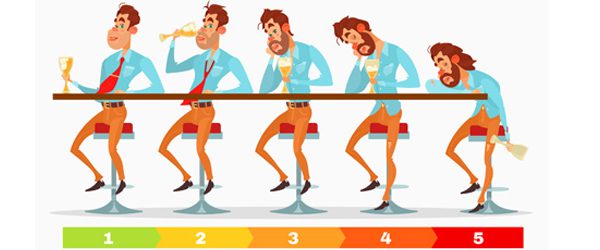

April is observed as “Alcohol Awareness Month”. It is a month aimed at educating and raising awareness of underage drinking, alcohol abuse, treatment, and other related issues. Observing this month-long event can be done as an individual, group, class or family.
Step 1 Talk with your kids, teens and young adult children. Getting the word across to your kids or teenagers about alcohol usage is very important. Many parents don’t realize what their kids do after school, at a friend’s house, or at a party. Teen peer pressure is one of the top reasons why kids start to drink. It is important to help your kids understand that alcohol is something to be had in moderation and not to be used either as a crutch for problems or as a social lubricant substitute for good conversation skills. There are set legal ages for drinking alcohol in most countries around the world. Help children, teens and young adults to understand that the reason for these laws is to protect them, not to deprive them. It’s not an easy sell but if they understand the facts, it can help considerably:
- Explain that some people use alcohol to relieve stress, only to find it causes more stress. Help your children and teens to know the difference between a celebratory drink and drinking that is used as a way to overcome unhappiness, worries or lack of confidence. Find more constructive ways to help your children and teens overcome these negative feelings, such as confidence building and exercising to release stress.
- Talk about how alcohol can consume a person’s daily life, causing an addict to allow everything to revolve around alcohol instead of leading a normal, healthy life. Alcoholism can also lead to arguments and violence.
- For teens and older, explain the statistics of deaths and injuries caused by alcohol, on the roads, at parties, and so forth, as relevant to your country. Reality hits hard but it’s best they know than pretend that alcohol isn’t going to cause them harm.
- Help children and teens to understand that it’s not just about themselves but about their friends, their family and about other people who might be harmed by another person’s alcohol consumption.
- Show by good example. The manner in which you use or abuse alcohol will have a big impact on your children’s attitude toward it. Are you showing them appropriate values toward alcohol? Teach your teens what the recommended intake of alcohol is for your country (it varies), so that when they’re old enough to consume alcohol legally, they’re aware of the limits for good health.
Step 2 Avoid over-consumption of alcohol at parties, pubs and other social drinking occasions. Stick to your daily limit and then switch to other non-alcoholic choices spiced up with great conversation and fun games like pool, darts or joke-telling. Have fun with mock drinks or sparkling cider. Help others who would like to enjoy parties without having to seem drunk show that it’s still possible to enjoy a get-together without imbibing too much alcohol.
- If alcohol is on the drink list, have a system of taking away vehicle keys of guests as they step in the door. Never let a drunk, even tipsy, person drive, even if they promise they’re okay. If it’s necessary, call a taxi or cab and have them pick their car up in the morning.
Step 3 Get employees who sell alcohol to double check the age. Depending upon the law of the country or state, a business or owner may be fined if the purchase of alcohol is sold to a minor. Bouncers, cashiers, and bartenders should double check and verify the actual birth date along with the current photo on the I.D. If there is no I.D. or the I.D. appears suspicious, then no alcohol should be sold.
Step 4 Know the effects of alcohol when pregnant. Fetal disorders may include low birth weight, prematurity, birth defects, and even death (miscarriage or stillborn). Never mix alcohol with pregnancy. Having a glass of wine is not a substitute or an excuse for “needing some”. Even the amount of caffeine taken should be monitored and in moderation but alcohol is definitely best left out of the pregnant woman’s daily intake. Speak to your doctor for precise advice on the matter if you’re pregnant.
Step 5 Recognize if you’re drinking too much. Sometimes we fall into drinking more alcohol than we ever intended, due to stressful jobs or home lives, or through peer pressure to “keep up”. If you find yourself drunk and hungover a lot, and others have been telling you to ease up, then it’s time to face reality. Use this month to learn more about the effects of alcohol long-term (as well as the obvious short-term impacts on your life) and to start minimizing your alcohol intake.
- If you say that you’re drinking too much and think you don’t drink more than anyone else but your friends and family are worried about your drinking and you’ve had mishaps when drunk, you may be in denial. Listen to what others have to say and seek help; realize that this isn’t affecting just you but is also affecting others around you.
Step 6 Convince your loved ones to seek advice if they’re suffering from a drinking problem, such as addiction to alcohol or rage brought on by drinking. Go with a loved one who has an alcohol problem to an AA (Alcoholics Anonymous) group session or any similar treatment program that matches your needs. Anything that is said within a therapy or group session room, stays in that room. With AA, anyone can remain anonymous; as the sharing of names is fully optional. Group sessions make people feel more comfortable because no one is alone in the world, they understand that there is another person dealing with the issue, and they can find ways and suggestions to help one another.
- Be supportive but not judgmental or enabling of any loved one who has problems with alcohol. Let them know that you care about them and that you’re a ready shoulder to lean on but that you won’t tolerate the continuance of the self-harm (and harm to others) through their drinking habit.
- Look after yourself if you’re living with an alcoholic. You may be worried all the time, which can drain you of energy. If you’re a victim of alcohol-caused violence, seek immediate help and safety. While it might be “the alcohol talking”, be well aware that the alcohol isn’t doing any listening either, so protect yourself and your children above all. Partners of heavy drinkers can feel intensely embarrassed and ashamed and may withdraw from public life when help is most needed. If this is your experience, seek help through family, friends, your doctor or local hospital, or AA.
Step 7 Teach and educate in school. Teachers and other guidance counselors can educate teenagers in school about alcohol abuse and the effects of it. Because this observance is for a month, create projects, essays, or lesson plans about it. Make brochures and other flyers relating to the daily lesson plan and have the students share what they’re learning with peers and family members.
- Teach children assertiveness and confidence skills; as skills, these are completely teachable and doable by each student. Having confidence and feeling assertive will remove the temptation to use alcohol as a crutch in difficult or testing social situations. Teach children not to bottle up their feelings; this leads to explosiveness and can lead to turning to the bottle too.
- Catch children at risk of or suffering from anxiety, depression, low self-esteem and self-hurting. These children may turn to alcohol to cope. The sooner they get help, the more likely they will be to learn coping skills that don’t include anesthetizing themselves with alcohol.
Source: https://www.wikihow.com/Observe-Alcohol-Awareness-Month



